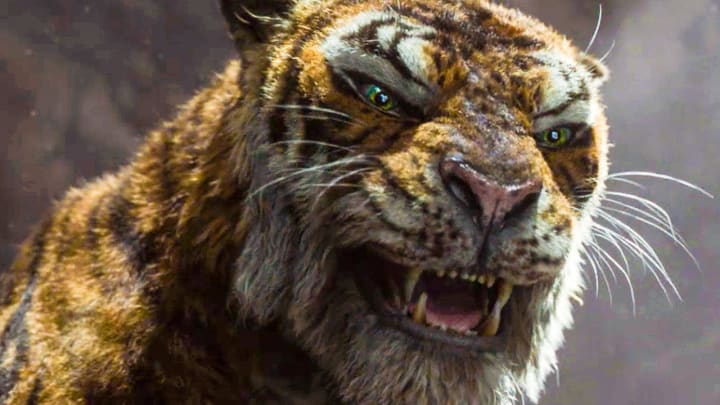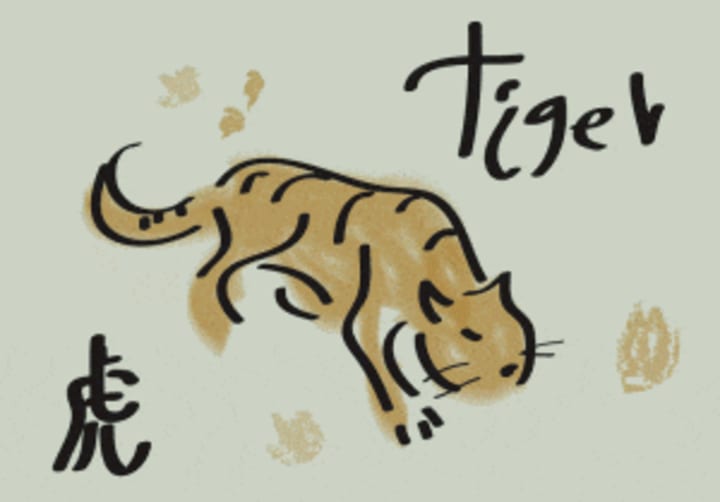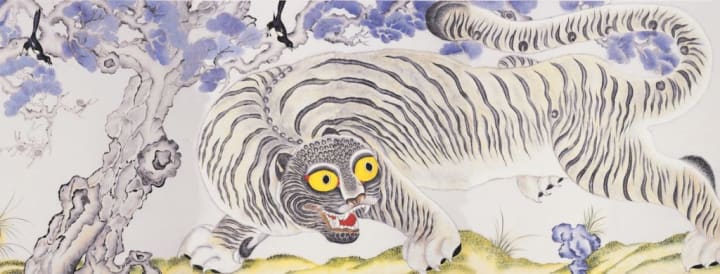The Tiger's Enduring Cultural Appeal
From movies, songs and clothes to cultural icons

Sleek, powerful, and mysterious, the tiger has been feared and revered by civilizations since before antiquity. The largest and most recognized of the big cats, this beautiful and critically-endangered creature remains an iconic symbol of strength and courage.
The national animal of Malaysia, South Korea, Bangladesh, and India, it is perhaps in China that the richest representations, traditions, and legends related to the tiger originate. In Western culture, too, the tiger has acquired mythical and legendary status through art, literature, and cinema.
The tiger is represented in numerous stories, films, cartoons, songs, and publicity. An early reference to the animal is found in 'The Tyger.' Published in 1794 in his collection 'Songs of Innocence and of Experience,' English poet William Blake describes the tiger as a menacing and fearful animal. Characters featured in Rudyard Kipling's 'The Jungle Book, include Shere Khan, a fictional Bengal tiger that's depicted as arrogant and feared greatly by the other inhabitants of the jungle. The striped antagonist would turn up again in several Disney adaptations of Kipling's classic.

A far more benign tiger was introduced to readers in the book 'Winnie-the-Pooh' by A.A. Milne. Called "Tigger," this tiger liked to bounce around with his buddies Pooh Bear, Eeyore the donkey, and Piglet. Disney made numerous animated productions starring the characters, and in 2000 released 'The Tigger Movie.
Ang Lee's magical movie adaptation of Yann Martel's 2001 novel of the same name tells the story of a young Indian man named "Pi" Patel who survives a shipwreck in the Pacific Ocean and shares a lifeboat with a fearsome Bengal tiger. At sea, Pi is hurtled into an epic journey of adventure and discovery. While cast away, he forms an unexpected connection with another survivor: a fearsome Bengal tiger "Richard Parker".

Even the ever-popular "The Walking Dead" series incorporated a tiger into their story writing. Shiva. Khary Payton’s Walking Dead character finally made his long-waited debut in season 7’s second episode. Shiva stuck with him closely, and also proved to be a formidable ally in combat against both the zombies and their human enemies, the Saviors. The tiger made multiple recurring appearances in the series, with her last coming in The Walking Dead season 8, episode 4, titled “Some Guy”, which was when the Kingdom was defeated by Negan’s army of Saviors. It was said that Shiva came to be in Ezekiel’s company after he saved the wounded zoo animal at the beginning of the zombie apocalypse.


Dozens of songs have been composed that contain the world "tiger" in the lyrics. One of the best known is 'Eye of the Tiger,' performed by Survivor and which became the theme song for the Sylvester Stallone movie 'Rocky III' (1982). The track received an Academy Award nomination for Best Original Song.
For millennia, the image of the tiger and what this striking apex predator represents has been woven into culture, religion, folklore, and ritual. As early as the Neolithic age, tigers were respected for their power, grace, and dignity. They were hunted for food, but the animal's discarded body parts were often used as ceremonial trinkets or to make amulets. Neolithic cave paintings are the earliest existing depictions of the tiger, etched into rock walls across the Indian subcontinent 8,000 years ago, and in China's Helan Mountains as well.

Elsewhere in the world, carving the outline of a tiger into rock symbolized early civilization's fascination with and fear of the mighty beast. India, China, and Japan have included tigers prominently in their various folklore, tales, and myths, with perhaps China being the richest country in representations, traditions, and legends related to the animal.
The Chinese were among the first to make detailed star maps, where 28 asterisms are recognized along the line of the zodiac—the Sun's apparent path across the sky. The rest of the heavens are divided into quadrants known as the Black Tortoise (North and winter season), Red Bird (South and summer season), Green Dragon (East and spring season), and White Tiger (West and autumn season).

In Greco-Roman tradition, tigers were kept in menageries and amphitheaters as exotic wildlife novelties. The animals were also pitched against gladiators in the ring. The Romans also depicted the tiger pulling a chariot being ridden by the god Dionysus, known to the Romans as Bacchus, the god of the grape harvest, winemaking, and wine.
The Tungusic peoples native to Siberia and Northeast Asia have always regarded the Siberian tiger as being close to a deity. Similarly, the Scythians, an ancient group of nomadic warriors who originally lived in what is now southern Siberia until the 3rd century BCE, revered the tiger.

In Buddhism, the tiger symbolizes rage and anger: the animal is one of the Three Senseless Creatures, which are animals ruled by a more basic human emotion. The monkey represents greed and the deer lovesickness. Conversely, in traditional Japanese culture, the tiger symbolizes strength and courage. Furthermore, the tiger, together with the dragon, govern the elemental forces of wind and rain, and have been revered for centuries as rulers of the cosmos and the natural world. The pairing of these beasts was believed to bring about blessings of rain and peace. The flying dragon and crouching tiger also came to represent heaven and earth.
The Hindu goddess Durga is depicted as a warrior figure with 10 arms going into battle riding a tigress called Damon. In Korean myth and culture, the tiger is a symbol of power and good luck and is regarded as a guardian or sentinel that drives away evil spirits and wrongdoers.

Shiva, one of the principal deities of Hinduism, is very often depicted wearing or sitting on tiger skin, or being accompanied by one of the beasts. In many parts of Vietnam, the tiger is a sacred creature. Tiger statues are usually seen at the entrance of temples and palaces in towns and villages across the country, keeping evil spirits from entering.

Tigers are the most magnificent of all the cats. It is one of the five 'big cats'. A large male tiger averages about 9 feet in length (from head to the end of the tail) The average height is about 3 feet at the shoulder and it can weigh up to 500-550 lb. A female tiger is slightly smaller, being about a foot shorter and about 30 to 50 pounds less in weight.
The total number of tigers living in the wild today is now believed to be much less than 5000.
There are multiple ways that we can step up and help Save The Tigers! These magnificent creatures have not only graced us with endless beauty and entertainment, but they have also served as protectors and allies for countless ages, now they need us to protect them!
About the Creator
Rebecca Lynn Ivey
I wield words to weave tales across genres, but my heart belongs to the shadows.
❤️Heart and subscribe!
💲Tips mean the world!






Comments
There are no comments for this story
Be the first to respond and start the conversation.